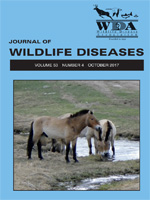Our objectives were to evaluate the effects of the 1) season, and 2) postmortem changes on serum biochemistries related with metabolism in Pyrenean chamois (Rupicapra pyrenaica pyrenaica). Serum samples from 98 animals obtained from 2009 to 2012 were included. To investigate seasonal influences on blood parameters, the Pyrenean chamois were captured in drive-nets during the feed abundant (FA; n=32) and food deficient (FD; n=35) seasons. To evaluate the possible differences in biochemistry analytes when sampling live or dead animals, we used serum samples from 32 captured animals and 31 dead animals (obtained during controlled hunting) in the FA season. Significant increases in high-density lipoprotein cholesterol (24%), nonesterified fatty acids (NEFA, 190%), total antioxidant capacity (68%), and haptoglobin (33%) were observed in FD when compared with FA seasons. Albumin and insulin-like growth factor-1 (IGF-1) showed statistically significant decreases of 10% and 11%, respectively, in samples taken in the FD season compared to the FA season. Statistically significant higher concentrations were found in serum low-density lipoprotein cholesterol (22%), triglycerides (28%), acetylcholinesterase (50%), NEFA (383%), albumin (18%), IGF-1 (53%), cortisol (959%), and paraoxonase-1 (20%) in samples collected from live animals compared to samples collected from dead ones. We demonstrated that season should be taken into account when evaluating serum biochemistries in Pyrenean chamois because, in the FD season, these animals present lipid mobilization, decreased albumin and IGF-1, and increased total antioxidant capacity compared with the FA season. In addition, if samples are taken from dead animals, observed decreases in serum low-density lipoprotein cholesterol, triglycerides, albumin, paraoxonase-1, acetylcholinesterase, NEFA, cortisol, IGF-1, and an increase in haptoglobin should be expected.
How to translate text using browser tools
1 October 2017
EFFECTS OF SEASON AND POSTMORTEM CHANGES ON BLOOD ANALYTES IN PYRENEAN CHAMOIS (RUPICAPRA PYRENAICA PYRENAICA)
Asta Tvarijonaviciute,
Ignasi Marco,
Rafaela Cuenca,
Santiago Lavín,
Josep Pastor
ACCESS THE FULL ARTICLE

Journal of Wildlife Diseases
Vol. 53 • No. 4
October 2017
Vol. 53 • No. 4
October 2017
blood
chamois
clinical pathology
lipid metabolism
Rupicapra pyrenaica pyrenaica
season
serum biochemistry




